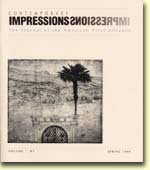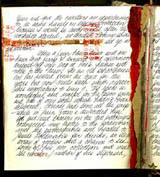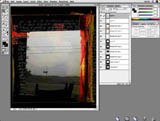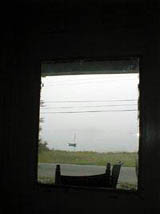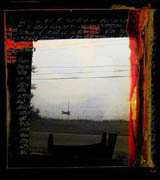![]() Home
Home
![]() The Alliance
The Alliance
![]() Exhibits
Exhibits
![]() Gallery
Gallery
![]() Resources
Resources
![]() Calendar
Calendar
![]() Competitive Exhibits
Competitive Exhibits
![]() Advocacy
Advocacy
![]()
![]() Technical Articles
Technical Articles
![]() Supplies
Supplies
![]() Links
Links
![]() Library
Library
Dorothy Simpson Krause & Stars of Hope
by Norma S. Steinberg
Reprinted from Contemporary Impressions, vol.6 #1, Spring 1998.
| Artists and writers regularly allege that technology-based prints are deficient in the sensuous and tactile properties of printmaking. Dorothy Simpson Krause's print Stars of Hope for 1998 subscribers to Contemporary Impressions is not only the first full-color, but also the first digitally-mastered print in the journal's series of artists' prints. With the evidence of the form and content in Stars of Hope before us, the case is won C this print is characterized both by lush color and texture and by allegorical, spiritual content.
Krause is a well-known, articulate spokesperson for digital art. She is professor of computer graphics at Massachusetts College of Art, corporate curator for IRIS Graphics, Inc. and a founding member of Unique Editionsú. Her education began at Montevallo University, Alabama (BA in painting), with graduate training at the University of Alabama (MA in education), Pennsylvania State University (Doctor of Education in art education), and Harvard University, Graduate School of Education. She organized "Digital Atelier: A printmaking studio for the 21st century" held in July 1997 at the National Museum of American Art and was an artist-in-residence there for twenty-one days with the other four members of Unique Editionsú: Helen Golden, Bonny Lhotka, Judith Moncrieff, and Karin Schminke. From various parts of the country, they work together to gain recognition for fine artists working with digital media. In addition to their roles as artists-in-residence, they invited members of the public to play with the computers and produce small color prints of their own. The Digital Atelierú had thirty-two corporate sponsors including Olympus, whose digital camera Krause uses, and Indigo, the firm contributing the printing for Stars of Hope. Krause hopes to take an abbreviated version of the workshop on the road. Krause and Lhotka were also invited to "Work Tank/Think Shop" organized by Pat Nick, director of Vinalhaven Press on the island of Vinalhaven, Maine. The week-long experience in September 1997 was designed to introduce a select group of museum curators to digital imaging. Experimentation at Vinalhaven typically involves traditional media rather than technological innovation, so this was a departure from that norm as well. Guests had the opportunity to learn firsthand about digital imagery from Krause and Lhotka, to visit several artists' studios, and otherwise address the nature of printmaking in the age of computer technology. While there, everyone took digital photographs that would be used in the imagery they produced. In fact, Stars of Hope combines three digital photographs Krause took that week. A Work Tank/Think Shop was followed by a symposium, Prints for the New Millennium, September 14, 1997, at Boston College, concurrently hosting an exhibition of prints produced at Vinalhaven. Some of the speakers seemed to confuse the technology with the finished print. Richard Field, curator of prints and photographs at Yale University Art Gallery and moderator of the symposium, for instance, spoke of the glowing transparent pictures that may be seen in an on-line virtual gallery. Deborah Wye, chief curator in the Department of Prints and Illustrated Books at the Museum of Modern Art, spoke about a digital file the museum had recently purchased by Peter Halley. She was considering the ways they hoped to install it to provide opportunities for viewer interaction. Although other speakers addressed conservation issues of Iris and other digitally-mastered prints, the potential of the printed digital image seemed linked to its digital file rather than to a fully realized print. In the case of the Halley, the file itself is a finished work of art. Most digital artists, however, conceive of the flickering screen as just the visible matrix (akin to a metal plate in intaglio printing) with the print being the completed work of art. Thankfully, Krause asked a question that returned the discussion to the final printed product and its potential. Other members of the audience asked about the criteria for quality in digital prints, the seeming domination of software, and the place for this type of multiple in the hierarchy of fine art media. Everyone agreed that quality is a blend of form and content in digital prints just as it is in traditional prints. Several speakers commented that the layering potential of graphics programs like Adobe Photoshop is sometimes too obvious and in such cases the final work suffers; others praised the seamlessness of digital art and considered the revived interest in photomontage to be a direct result of the capacity for layering effects Stars of Hope was printed on the Indigo Eprint 1000, which prints one thousand sheets per hour. The images were printed two to a sheet of Arches paper and trimmed to the size of the journal. Each print was hand-signed. As with all digital prints, final print production is mechanically driven, not hand-pulled. We see no embossed border indicative of an intaglio press and no actual texture bumps up the paper. This process is closest in traditional print media to lithography, with its washes and multi-colored dots. In the strongest color areas of Krause's print, the red or black areas for example, the color is solid and deep. Only in the paler, more transparent areas like the window may one detect (with ten-power magnification) the fine colored dots of the digital printing process. Krause has found ways to eliminate virtually any sign of possibly offensive digital dots. She might use paint or colored pencils and draw into lighter areas. Washing with a damp paint brush will also blend the dots. Most often these days Krause will use a transfer method of printing that she developed at last year's Beyond the Digital Print, a workshop taught at the Massachusetts College of Art. She starts by digitally printing with waterbased inkjet dyes onto a specially prepared substrate. The next step is like traditional printmaking, with the printed image treated like a plate: it is covered with dampened paper and blankets and run through an intaglio press. The ink transfers entirely to the dampened paper by capillary action as if it were a monoprint. Dark tones, especially the blacks which have been printed first in the inkjet process, come off last in the transfer and sit on the surface of the image, generating a rich shade. The secret of this transfer method is the precoat. Many substrates used for inkjet printing already have a hard surface coating: because the ink is not absorbed, it is readily released. Krause has transferred inkjet dyes to dampened paper using a spoon or rolling pin, even from year-old inkjet prints. The final paper can be rough or otherwise unsuitable for direct inkjet printing. One can print a full bleed and deckle edges. The artist can combine several inkjet prints on a single sheet of etching paper and produce a very large image C a physical collage from virtual collages. Three of the many digital photographs Krause took at Vinalhaven were incorporated into her computer image files for Stars of Hope. The first is an angel painted many years ago by Mauricio Lasansky on the wall at "The Poor Farm" where the eight curators stayed. The second component is a boat at anchor in Vinalhaven harbor, seen through a window in Pat Nick's home, and the third is a hand-written, collaged page from Krause's personal journal recording her impressions of the meeting on Vinalhaven. Another component of the image is a set of small alphabet stamps she purchased on a recent trip to Vietnam (where she first began to keep and design personal journals). She kept the alphabet blocks taped together just as purchased and used them as a recurring motif in the journal. The final digital file includes eleven layers, each of which has been produced using the many different adjustment options in Adobe Photoshop. The illustration of a screen shows her "layer 3" in the center, with all the layers in miniature at the right. Here, the angel is nearly intangible at an opacity level of twenty per cent. One layer intensifies the stars, another the reds and yellows, and yet another is a negative reversal of the image. Prior to printing, the file is flattened into a single layer and saved in a format suitable for the inkjet printer. Control might seem to be indigenous in machine-made art, as opposed to traditional printmaking which utilizes both control and accident in producing imagery. Digital image-makers are not aloof, however, from the incorporation of accidental marks and effects in their work. Krause uses Adobe Photoshop software because the layering potential and composite manipulations encourage opportunities for accidental effects in textures and color shifts. The title of Krause's print refers to several sources. It is adapted from the name of Robert Indiana's home and studio on Vinalhaven Island, a former Oddfellow's Hall called Star of Hope, one of the sites the group visited during their educational week. Little gold stars, like the ones used to recognize our accomplishments in grade school, are a part of the collage elements in the journal, and they are barely visible in the final print at lower right. Krause told the author that the title might also refer to the eight curators at Vinalhaven, each a star in his or her own galaxy and, she wistfully added, people she hoped might one day appreciate digital printing as an important tool in printmaking and art in general. Layered together in a single image, the components in Stars of Hope evoke the idyllic quality of the Vinalhaven adventure. The red and yellow stains at the edge of the written page are transformed in the print into semi-transparent draperies that seem to blow into the room from the open window in the boat layer. Two chairs on Pat Nick's front porch melt together in the final print, seemingly a foreground enlargement of the horizontal of the dory and at the same time a repetition of the negative space just above them. The boat's mast and its reflection form a delicate vertical just below the center. The painted angel is a cloud-like apparition floating decorously behind fractured lettering that itself sits on a transparent layer in front of most of the picture. Power lines in the original photograph were removed, and then deliberately reinstated, as a set of parallel lines to divide the space into unequal rectangles. Krause derives imagery from a number of sources. In several of her recent images, she has focused on a central figure. In Stars of Hope the central figure is so ephemeral that we see the window, not the angel flying by. This motif of a central opening appears in several other works in recent years, including Against the Wall, Kneeling at the Gate and Tattoo. Some might read the opening as a feminine form, but that interpretation is not consonant with this latest image. Rather, the opening is reminiscent of the open windows of nineteenth-century romantic painters, where the presence of a window represents both yearning for freedom and safety from the trials outside. As such, the print is narrative and the apparent representation supports this reading. On one level, Krause also intended the work as a pleasant reminder of the summer workshop; with its little boat adrift on the calm ocean, it functions well as a sentimental souvenir. It is not an intense work notwithstanding the dynamic reds; rather it is contemplative and spiritual. Without an actual person, we still recognize the human presence in the rocking chairs and the boat and the open window ÷ the essential humanity requisite of any art activity. Critics for main-line journals rarely review exhibitions devoted to digital art. Several art critics and historians have stated that digital art is fine as long as it does not look like digital art. It cannot be too obviously layered, as one person stated at the symposium. While Krause agrees with this position on layering, she also believes that digital art should have something about it that could not be produced in any other way. In this print, differences in density, for instance the nearly transparent angel, are one indicator of the digital. The handwriting, partly destroyed and partly readable, partly dark-on-light and partly light-on-dark, is another sign of digital mediation. We need to be open to looking at work accomplished with these no-longer-new tools. Abstract yet readable, contemplative yet potent, figurative yet virtual, Stars of Hope stands as a beacon bridging the gap between new and old technologies. Footnotes:
|
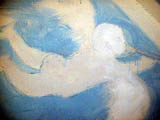 Drawing of Angel
|
